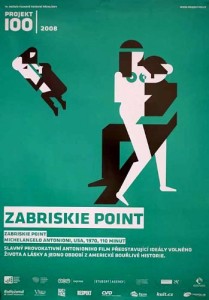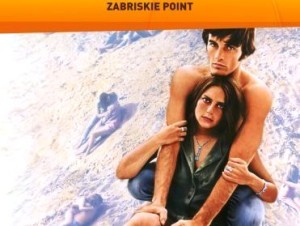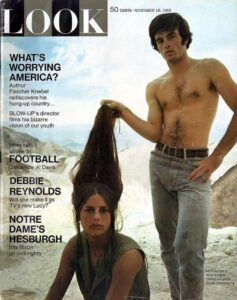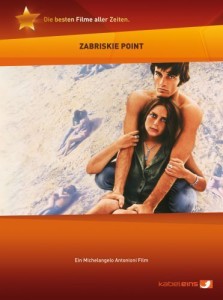Zabriskie Point **** (1970, Mark Frechette, Daria Halprin, Rod Taylor, Paul Fix) – Classic Movie Review 2840
Co-writer/director Michelangelo Antonioni’s fascinating if somewhat misguided 1970 American odyssey film Zabriskie Point follows the misadventures of student radical dropout Mark (Mark Frechette).
He is accused of a cop’s murder during a student riot, pilots a plane through Death Valley and falls in with a gorgeous beatnik secretary and anthropology student called Daria (Daria Halprin), who is helping a property developer build a village in the Los Angeles desert.
Antonioni’s movie is highly inventive, cinematic and astonishing to behold. But it is very much a flawed product of some of the wackier aspects of its time. It is full of cringe-worthy hippie-speak, counter-culture clichés and a naive, all-pervading earnestness. Supposedly a statement on the rising violence in America and the increasing chasm between the repressive US establishment and the Sixties counter-culture, it seems a bit empty intellectually.
But time has been kind to Antonioni’s film. It stands tall as an epic portrait of late-Sixties America. Antonioni magically and uniquely captures the zeitgeist in California like he did earlier in London with Blow-Up (1966).
Also in the cast are Rod Taylor as Lee Allen, Paul Fix as Roadhouse owner, G D Spradlin as Lee’s associate, Kathleen Cleaver as Kathleen and Bill Garaway as Morty. Harrison Ford’s part was cut from the final print, though you can see him standing up against the back wall in the jail scene as one of the arrested student demonstrators being held inside a Los Angeles police station.
Made for MGM and producer Carlo Ponti, Zabriskie Point was a costly ($7 million) movie and a major box office failure, initially grossing only $900,000, despite all the publicity and controversy it attracted.
The running time is alternate version.
‘A director’s job is to see,’ Antonioni said. Well, I see.
In the US for the 1966 premiere of Blow-Up, Antonioni saw a newspaper article about a young man who had stolen an aircraft and was killed when he tried to return it in Phoenix, Arizona. After writing many drafts, he hired playwright Sam Shepard to write the script. Shepard, Antonioni, Italian film-maker Franco Rossetti, Antonioni’s regular screenwriter Tonino Guerra and Clare Peploe (later the wife of Bernardo Bertolucci), worked on the screenplay.
Some scenes were shot at the real Zabriskie Point in Death Valley.
The original ending was a shot of an airplane sky-writing the phrase ‘F*** You, America’, which was cut by MGM president Louis F Polk along with other scenes. Polk was replaced by James T Aubrey, who restored most of the footage, though not the final shot.
Remembering the scoring sessions for this film, members of Pink Floyd said that Antonioni was difficult to please (‘Eets nice, but too slow’).
Frechette was not an actor but a carpenter and led a counterculture life much like his character’s, and had frequently been arrested. Casting director Sally Dennison spotted him having an argument at a bus stop in Los Angeles, and recommended him to Antonioni, saying: ‘He’s 20 and he hates.’
Frechette and Halprin fell in love and moved together to self-styled guru Mel Lyman’s experimental Fort Hill Community, a 100-member commune. She later was married to Dennis Hopper for four years (1972 – 1976) and they had a child, Ruthanna Hopper. In 1968 Halprin appeared in Revolution, a documentary by Jack O’Connell and in 1972 she appeared in John Flynn’s thriller The Jerusalem File. In the 1970s, she developed an interest in creative arts therapy. In 1978, she and her mother Anna founded the Tamalpa Institute and developed the Halprin Process.
Three years after Zabriskie Point Frechette was jailed for a bank hold-up in Boston with three other members of the Fort Hill Community, using a gun with no bullets. He died in prison in 1975, aged 27, supposedly during a weight-lifting exercise when a barbell fell on his neck.
The love-making scene in Death Valley was filmed with dust-covered and highly choreographed actors from The Open Theatre of Joe Chaikin. Antonioni found himself under investigation by the US Department of Justice, state officials in Sacramento and in Oakland, California, and FBI officials.
The soundtrack includes music from Pink Floyd, The Youngbloods, Kaleidoscope, Jerry Garcia, Patti Page, Grateful Dead, the Rolling Stones, and John Fahey. Roy Orbison wrote and sang the theme song, over the credits, called ‘So Young (Love Theme from Zabriskie Point)’.
It premiered on 5 February 1970.
© Derek Winnert 2015 Classic Movie Review 2840
Check out more reviews on http://derekwinnert.com









